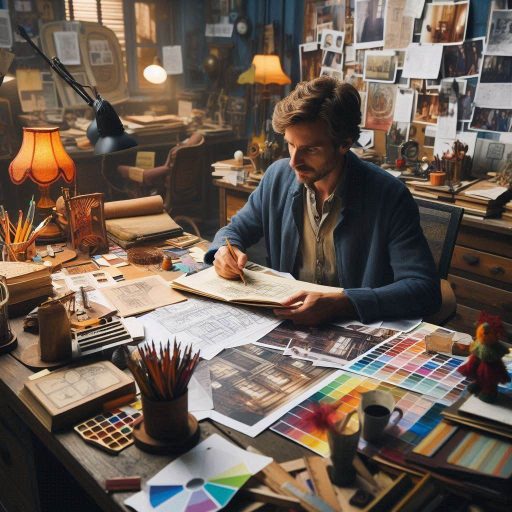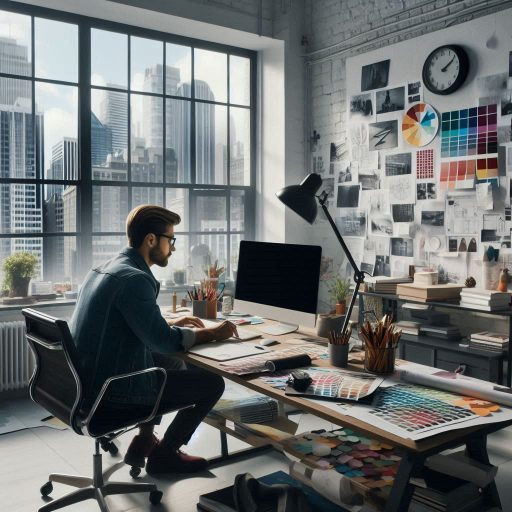Introduction
Budgeting for film and TV production design is essential for a successful project.
A well-planned budget ensures that designers have the resources needed to execute their vision.
It helps allocate funds for materials, labor, and other necessary elements while maintaining financial control.
Effective budgeting also promotes collaboration among departments.
When everyone understands the financial constraints, teams can work together to find creative solutions.
This collaborative spirit often leads to innovative design approaches that stay within budget.
However, misconceptions about budgeting exist in the industry.
Many believe that a larger budget guarantees better production design.
While more funds can enhance quality, creativity often thrives within financial limitations.
Skilled designers can produce remarkable results without excessive spending.
Another common misconception is that budgeting only happens at the start of production.
In reality, budgeting is an ongoing process.
Production designers must continuously assess expenses, adjusting plans as necessary to stay on track.
Budgeting is crucial for effective film and TV production design.
It enables proper resource allocation and fosters collaboration.
Understanding and addressing common misconceptions about budgeting can lead to successful, visually captivating projects within financial constraints.
Understanding the Scope of the Project
Assessing the Script and Identifying Key Elements That Require Design Work
Budgeting for film and TV production design begins with a thorough script assessment.
Designers must read the script multiple times to grasp its essence.
They identify key scenes that require significant design work, such as unique sets, props, and costumes.
Each scene’s visual requirements can greatly influence the budget.
For instance, an elaborate set may require more resources than a simple one.
Designers note locations that necessitate specific designs and materials.
They also consider any unique elements that enhance storytelling.
Important aspects include special effects, period accuracy, and character-specific props.
For example, a historical drama demands research into authentic period details.
This attention to detail can increase the overall budget due to specialized materials or craftsmanship.
Additionally, designers should collaborate with the director and producers during the script assessment.
These discussions help align the design work with the project’s overall vision.
Identifying design priorities early enables a more accurate budget estimate.
Once key elements are identified, designers can outline their specific needs.
This includes the materials required for each design element.
Having a clear understanding allows for better financial planning.
It also prevents unexpected costs later in production.
Furthermore, designers can categorize elements into essential and non-essential items.
Essential items are critical for storytelling, while non-essential items can be adjusted or eliminated.
This categorization aids in making budgetary decisions without sacrificing quality.
Determining the Overall Vision and Style of the Project
Once key design elements are identified, the next step involves determining the overall vision and style.
This vision guides all design decisions throughout production.
Designers should work closely with directors and cinematographers to ensure consistency.
Developing a clear visual style is crucial.
Designers can create mood boards to illustrate the desired aesthetic.
These boards include color palettes, textures, and visual references that align with the project’s tone.
Understanding the target audience also informs the style.
Different genres demand distinct visual approaches.
For instance, a comedy may require bright colors and whimsical designs, while a thriller might lean toward darker tones and shadows.
The project’s scope also influences the design vision.
A low-budget indie film may necessitate creative solutions for set designs.
In contrast, a big-budget production may allow for more elaborate creations.
Additionally, designers must consider practicalities such as space and resources.
They should evaluate how their design vision fits within the available budget.
Adapting the vision to meet financial constraints fosters creativity and innovation.
Throughout this process, constant communication is essential.
Designers should maintain dialogue with the production team.
This collaboration ensures that everyone shares the same vision and expectations.
Effective budgeting for film and TV production design starts with a detailed script assessment.
Identifying key design elements allows for accurate budget estimations.
Determining the overall vision and style ensures coherence in the design process.
By aligning the budget with the creative vision, designers can create visually compelling productions while staying financially responsible.
Through careful planning and collaboration, the production design will enhance storytelling and resonate with audiences.
Read: Freelance Character Design: How to Get Started
Researching and Gathering Estimates
Researching Costs of Materials, Props, Sets, and Labor
Budgeting for film and TV production design begins with thorough research.
Understanding the costs of materials is crucial for accurate budgeting.
Production designers must identify the specific materials required for each project.
This includes everything from wood and fabric to paint and hardware.
Procuring props also involves detailed cost analysis.
Production designers should list all necessary props early in the planning phase.
This includes items like furniture, decorations, and specialized equipment.
Knowing the prices of props allows designers to allocate funds effectively.
Sets represent a significant portion of the production design budget.
Designers must consider the complexity of each set when estimating costs.
Factors like size, materials, and design intricacy influence the overall expense.
Designers should gather cost information from multiple sources to ensure accuracy.
Labor costs are another essential component of the budget.
This includes wages for set builders, painters, and decorators.
Production designers should account for the time each task requires.
Understanding labor costs helps in planning the project timeline effectively.
In addition to these basic costs, production designers must consider unforeseen expenses.
It is wise to allocate a contingency fund for unexpected issues.
This preparation ensures that the project stays on track even when surprises arise.
Gathering Estimates from Vendors and Production Designers
Gathering estimates from vendors is a critical step in the budgeting process.
Production designers should build relationships with reliable suppliers early in the project.
Communicating with vendors helps establish trust and ensures better pricing.
Designers must request detailed quotes from multiple vendors.
Comparing these quotes allows designers to find the best prices for materials and props.
When evaluating vendor estimates, consider not only price but also quality and delivery times.
Communication is vital when working with vendors.
Production designers should clearly outline their needs and expectations.
This clarity helps vendors provide accurate estimates and avoids misunderstandings later.
In addition to vendor estimates, designers should consult with experienced production designers.
Their insights can offer valuable perspectives on cost-effective materials and methods.
They can also suggest reliable vendors with competitive pricing.
Using software tools can streamline the budgeting process.
Budgeting software allows designers to organize estimates and track expenses efficiently.
This organization helps designers stay within budget and manage their spending.
As production designers gather estimates, they must continually refine their budget.
Regularly updating the budget helps reflect changes in costs and project scope.
This ongoing assessment ensures that designers maintain financial control throughout production.
Budgeting for film and TV production design requires careful research and planning.
Understanding the costs of materials, props, sets, and labor is essential for creating accurate budgets.
Gathering estimates from vendors and consulting with experienced designers further enhances this process.
By taking these steps, production designers can successfully manage budgets and contribute to the project’s overall success.
Read: Career Paths: Becoming a Professional Character Designer
Creating a Detailed Budget
Breaking Down the Budget into Categories
Budgeting for film and TV production design involves careful planning and organization.
First, break down the budget into clear categories.
Common categories include set construction, props, costumes, and the overall art department.
Set Construction forms the backbone of any production.
This category includes materials, labor, and equipment costs.
Accurately estimating these expenses helps avoid overspending during production.
Props enhance the visual storytelling in a project.
They add depth and realism to the sets and characters.
Allocate funds for purchasing or renting props that align with the production design.
Costumes play a vital role in character development.
Investing in high-quality costumes can elevate a production’s overall aesthetic.
Be sure to include costs for fabric, tailoring, and accessories in your budget.
The Art Department encompasses various design elements, including graphics and visual effects.
This category includes salaries for art department personnel and costs for art installations.
Ensure you account for every detail to achieve a cohesive look.
Establishing a detailed budget breakdown allows for better financial management.
Each category should reflect the production’s specific needs and requirements.
A well-structured budget ensures that resources are allocated efficiently throughout the project.
Allocating Funds Based on Priority
Allocating funds effectively is crucial for staying within budget.
Begin by identifying the project’s priority elements.
Understand which aspects of production design are essential for the story.
For instance, if a film features elaborate sets, allocate more funds for set construction.
Conversely, if the focus is on costumes, prioritize that category instead.
This assessment ensures that critical design elements receive adequate financial support.
Consider collaborating with the director and production team during this process.
Their insights can help identify which elements are most vital.
Engage in discussions to align your budget with the overall vision of the project.
Flexibility is essential in budgeting.
Production designers should be prepared to adjust allocations as needed.
Unexpected costs may arise during production, requiring reallocation of funds.
Implement a contingency plan to address unforeseen expenses.
A general rule is to set aside 10-15% of the total budget for contingencies.
This buffer can prevent financial strain if unexpected costs arise.
Regularly review the budget throughout the production process.
Monitor expenses closely to ensure adherence to the budget.
If certain categories are over budget, explore potential areas to cut costs.
Communicate any budget adjustments with the production team.
Transparency helps maintain trust and collaboration among all departments.
Keeping everyone informed allows for better decision-making regarding design choices.
In fact, budgeting for film and TV production design requires careful categorization and prioritization.
Breaking the budget into categories such as set construction, props, and costumes helps streamline financial management.
Allocating funds based on project priorities ensures that essential design elements receive the necessary support.
Flexibility, communication, and regular budget reviews are crucial for a successful production.
By approaching budgeting strategically, production designers can create stunning visuals while staying within financial constraints.
Read: Best Tools and Software for Character Designers

Negotiating and Finding Cost-Saving Solutions
Negotiating with Vendors and Suppliers
Budgeting for film and TV production design involves effective negotiation with vendors and suppliers.
Negotiating can significantly reduce costs while maintaining quality.
Production designers must establish clear communication with vendors from the start.
Identifying potential suppliers is the first step in the negotiation process.
Research local and online suppliers that offer materials relevant to the project.
Compile a list of vendors who specialize in set design, props, and materials.
Next, initiate contact with these suppliers.
Explain your project and inquire about pricing options.
Many vendors appreciate transparency and are willing to work with budgets.
Don’t hesitate to ask for discounts or package deals.
When negotiating, be prepared to share specific details about your project.
Providing information about the scale, timeline, and budget helps vendors understand your needs.
This clarity often encourages vendors to offer tailored solutions and discounts.
Building relationships with suppliers can also yield long-term benefits.
Frequent collaboration may lead to preferential pricing and special offers.
Cultivating these relationships fosters trust and encourages vendors to prioritize your needs.
Additionally, consider leveraging multiple suppliers for the same items.
Requesting quotes from various vendors allows for competitive pricing.
This approach can help identify the best deals available in the market.
Finally, don’t overlook the value of bartering.
Some vendors may be open to exchanging services or products.
Offering promotional opportunities in exchange for discounts can be mutually beneficial.
Finding Creative Solutions Within Budget Constraints
Finding creative ways to achieve the desired look within budget constraints is essential in production design.
Many successful projects thrive on ingenuity and resourcefulness.
Production designers should embrace innovative strategies to maximize their budget.
One effective method is to repurpose existing materials.
Instead of purchasing new items, consider using elements from previous projects.
This approach reduces costs and promotes sustainability within the production process.
Using local resources can also help save money.
Sourcing materials and props from local businesses can significantly reduce shipping costs.
Moreover, local suppliers often have unique items that can enhance authenticity.
Incorporating DIY elements into the design can yield impressive results.
Simple, handmade props or set pieces can add character without breaking the bank.
Involving the crew in the creative process fosters teamwork and can lead to unique designs.
Exploring alternative materials is another way to stay within budget.
Instead of high-end finishes, consider affordable substitutes that achieve a similar look.
For instance, using plywood instead of hardwood can save money while maintaining visual appeal.
Collaboration with the art department is crucial for maximizing resources.
Sharing ideas and pooling materials can lead to innovative solutions.
Encouraging input from the entire team enhances creativity and fosters a sense of ownership.
Finally, prioritizing essential elements over extravagant details helps manage budgets.
Focusing on the core aspects of the design ensures that the project’s primary goals remain intact.
This strategy allows for a polished final product without overspending.
In fact, effective budgeting for film and TV production design involves negotiating with vendors and finding creative solutions.
By establishing relationships with suppliers and exploring innovative strategies, production designers can achieve their vision within financial constraints.
Resourcefulness and collaboration are key to maximizing budgets while delivering exceptional results.
Embracing these practices leads to successful productions that captivate audiences without compromising quality.
Read: Ceramic Art: From Hobby to Professional Career
Tracking Expenses and Managing Costs
Implementing a System for Tracking Expenses in Real-Time
Budgeting for film and TV production design requires an effective tracking system.
Implementing real-time expense tracking helps maintain financial control.
Production designers should use software tools designed for budgeting and tracking.
These tools streamline the process, allowing designers to update expenses quickly.
Creating a detailed budget plan is essential before production begins.
This plan should outline all anticipated costs, including materials and labor.
Designers must include contingency funds to cover unexpected expenses.
A well-structured budget plan provides a solid foundation for tracking.
Once the production starts, tracking expenses in real-time becomes crucial.
Regularly updating the budget allows designers to see where funds are allocated.
This visibility helps identify potential overspending before it becomes an issue.
Communication between team members is vital for effective tracking.
Designers should encourage open dialogue about expenses with the crew.
Regular meetings can help ensure everyone stays informed about the budget status.
When everyone understands the financial constraints, they can make better decisions.
Assigning specific budgetary responsibilities to team members improves accountability.
Each team member can be responsible for their allocated budget section.
This approach encourages ownership and diligent tracking of expenses.
Regular check-ins can help ensure that everyone is on the same page.
Using visual aids, such as charts and graphs, can enhance tracking efforts.
These tools provide a quick overview of spending patterns.
Visual representations make it easier to spot trends and anomalies.
When designers can visualize their budgets, they can make informed adjustments.
Monitoring Spending to Ensure the Project Stays on Budget
Monitoring spending is critical to keeping production design projects within budget.
Regular budget reviews help identify discrepancies between projected and actual costs.
Designers should set specific milestones for reviewing budget performance.
Establishing spending limits for each department helps control costs.
Designers must communicate these limits clearly to all team members.
This approach fosters a sense of responsibility among the crew.
When everyone is aware of spending limits, they can make informed decisions.
Using a contingency fund can cushion the impact of unexpected expenses.
Designers should allocate a percentage of the budget for unforeseen costs.
This fund can help manage emergencies without derailing the overall budget.
Another effective strategy is to prioritize expenses.
Designers must distinguish between essential and non-essential items.
By focusing on critical elements first, they can allocate resources efficiently.
This prioritization ensures that the most crucial aspects receive adequate funding.
Tracking recurring expenses throughout the production is essential.
Understanding ongoing costs helps designers anticipate future spending needs.
Regularly updating budget forecasts based on these insights enables proactive decision-making.
Encouraging team collaboration also aids in monitoring spending.
By involving team members in budget discussions, designers foster a collective sense of accountability.
This collaboration can lead to innovative solutions for managing costs.
In short, effective budgeting for film and TV production design requires a systematic approach.
Implementing real-time expense tracking and monitoring spending are critical components.
Designers should use tools that streamline tracking, encourage communication, and prioritize expenses.
By maintaining financial control, production designers can deliver successful projects within budgetary constraints.
Allocating Contingency Funds
Setting Aside a Contingency Fund for Unforeseen Expenses or Emergencies
Budgeting for film and TV production design requires careful planning.
A contingency fund is crucial for handling unforeseen expenses.
Unexpected costs can arise at any stage of production.
These may include last-minute changes, equipment failures, or additional materials.
Setting aside funds for emergencies ensures that production continues smoothly.
It allows the team to address issues without delaying the project.
A contingency fund provides financial security and peace of mind.
This fund can cover expenses that were not initially anticipated.
Without a contingency fund, projects may face serious challenges.
Teams might scramble to find quick solutions, which can lead to poor decisions.
Stress can also escalate, affecting the overall morale of the production team.
Establishing a contingency fund mitigates these risks and enhances project stability.
Producers should assess potential risks during the planning stage.
Identifying possible challenges helps determine the appropriate size of the contingency fund.
Engaging with the production team allows for more comprehensive risk assessment.
This collaboration provides valuable insights into potential unforeseen expenses.
Determining a Percentage of the Budget to Allocate for Contingencies
Determining the right percentage of the budget for contingencies is crucial.
Industry standards typically suggest allocating 5% to 10% of the total budget.
However, this percentage can vary based on the project’s complexity and scope.
For smaller projects, a 5% allocation may suffice.
Larger productions with intricate designs may require up to 10%.
Evaluating the specific needs of each project helps establish the right figure.
This ensures that the contingency fund is adequate for potential issues.
Production designers should collaborate with producers to finalize the contingency percentage.
Understanding the overall budget structure provides valuable context.
This collaboration allows the team to set realistic financial expectations for the project.
Additionally, the contingency fund should be monitored throughout production.
Regular budget reviews help track expenses and identify areas for adjustment.
If costs exceed expectations, the team may need to access the contingency fund.
Conversely, if savings occur, the team can reallocate those funds elsewhere.
Communication among team members is essential for effective budgeting.
Regular updates about the budget status keep everyone informed.
This transparency helps prevent misunderstandings regarding financial matters.
Maintaining open lines of communication fosters trust and collaboration.
Ultimately, budgeting for film and TV production design requires foresight and adaptability.
Setting aside a contingency fund for unforeseen expenses is a proactive approach.
Determining an appropriate percentage to allocate for contingencies protects the project from unexpected challenges.
This strategic planning enhances the overall efficiency and success of the production.
A well-structured budget includes a contingency fund.
Allocating a percentage for contingencies safeguards the production against unforeseen challenges.
By planning ahead and fostering open communication, teams can navigate potential hurdles effectively.
This approach ensures a smoother production process and contributes to a successful final product.
Communicating and Collaborating with the Production Team
Keeping the Production Team Informed About Budget Constraints
Budgeting for film and TV production design is crucial for success.
Keeping the production team informed about budget constraints fosters transparency.
This transparency helps everyone understand financial limitations and make informed decisions.
Early communication about the budget is essential.
Designers should discuss financial parameters during pre-production meetings.
This discussion ensures that all team members know their limits from the start.
Regular budget updates help the team stay on track.
Production designers should provide updates at key milestones.
This practice keeps everyone aligned with financial goals and encourages accountability.
When designers understand budget constraints, they can prioritize essential elements.
They can allocate resources to areas that significantly impact storytelling.
This focus enhances the visual narrative while staying within budget limits.
Furthermore, open communication allows for creative solutions.
If a design element is too costly, the team can brainstorm alternatives.
This collaboration often leads to innovative ideas that fit the budget.
Designers should also track expenditures throughout the production process.
Monitoring costs helps identify potential overruns early.
When designers detect issues promptly, they can adjust plans to prevent budget overruns.
Involving the entire production team in budget discussions fosters collaboration.
Everyone should feel responsible for adhering to budget constraints.
This shared accountability promotes a sense of teamwork and collective ownership.
Collaborating with Other Departments to Streamline Costs
Collaboration between departments is vital for effective budgeting.
Production designers must work closely with other teams to streamline costs.
This collaboration enhances efficiency and maximizes available resources.
Communication with the art department is essential.
Designers can share insights about set construction costs and materials.
This information allows the art department to make informed choices that align with budget constraints.
Additionally, collaborating with the costume department can reduce expenses.
Designers should coordinate to avoid duplication of materials or resources.
This practice ensures that all departments utilize resources efficiently and effectively.
Location scouting is another area where collaboration proves beneficial.
Designers can work with location scouts to find affordable yet visually appealing sites.
These partnerships help control costs while maintaining quality.
Production designers should also engage with the visual effects team.
Combining practical effects with digital enhancements can save money.
This collaboration allows for creative solutions that fit the budget without sacrificing quality.
Furthermore, leveraging local talent and resources can reduce costs.
Hiring local artisans for set construction or props often proves more economical.
This approach not only saves money but also supports the local economy.
Lastly, maintaining open lines of communication throughout the production is essential.
Regular check-ins help teams identify potential cost-saving measures.
By staying connected, departments can adapt quickly to changing circumstances.
Effective budgeting for film and TV production design is vital for success.
Keeping the production team informed about budget constraints promotes transparency and accountability.
Collaborating with other departments streamlines costs and maximizes resources.
By fostering teamwork and open communication, production teams can create stunning visuals without exceeding budget limitations.
Prioritizing budget management ultimately leads to a successful and efficient production process.
Revising and Adjusting the Budget as Needed
Evaluating the Budget Throughout the Production Process
Budgeting for film and TV production design requires constant evaluation.
Production designers must monitor expenditures at every stage of the project.
Regularly reviewing the budget helps identify any overspending or areas that need adjustments.
During pre-production, designers estimate costs for materials, labor, and equipment.
They collaborate with producers to establish a realistic budget based on the project’s needs.
This initial budget serves as a roadmap for the entire production process.
As production progresses, unexpected expenses often arise.
Designers must evaluate these changes and adjust the budget accordingly.
For example, if a last-minute design alteration requires additional materials, it may impact the overall budget.
Production designers need to track all expenses meticulously.
Using budgeting software or spreadsheets can streamline this process.
Accurate record-keeping allows designers to see where money is being spent and identify potential savings.
Communication with the production team is essential during this phase.
Designers should update producers about any financial changes that may affect the project.
Transparent communication fosters a collaborative environment and ensures everyone stays informed.
Budget reviews should occur regularly throughout filming.
These evaluations help designers assess if they remain within budget limits.
If costs exceed estimates, designers must strategize to find solutions without compromising quality.
For example, they might opt for more affordable materials or simplify certain designs.
Such adjustments allow designers to maintain the project’s integrity while adhering to budget constraints.
Transform Your Career Today
Unlock a personalized career strategy that drives real results. Get tailored advice and a roadmap designed just for you.
Start NowBeing Flexible and Adaptable to Changes
Flexibility is crucial in the world of production design.
Projects often evolve, requiring designers to adapt quickly to new requirements.
Whether it’s a script change or a shift in the director’s vision, designers must be prepared.
Adaptability allows designers to embrace new ideas and incorporate them into their designs.
For instance, a new character might require additional set elements or props.
Designers must respond promptly to these changes while staying within budget.
Being proactive helps production designers manage changes effectively.
Anticipating potential challenges can mitigate last-minute adjustments.
Regular discussions with directors and producers can uncover any anticipated shifts in the project.
Production designers should also cultivate strong relationships with vendors and suppliers.
This network can provide alternative options or last-minute materials at a lower cost.
A flexible approach helps designers navigate unexpected challenges without compromising quality.
Collaboration with other departments enhances adaptability.
By working closely with art directors and set decorators, designers can develop creative solutions.
These partnerships encourage innovative thinking and resourcefulness, which are vital in a dynamic production environment.
Moreover, a willingness to compromise is important.
Production designers may need to adjust their visions to meet budgetary constraints.
Prioritizing the project’s overall goals ensures that the final product remains cohesive and impactful.
Budgeting for film and TV production design requires ongoing evaluation and adaptability.
Designers must continuously assess their budgets, making adjustments as necessary.
Flexibility and collaboration are essential for managing changes in project requirements.
By staying proactive and maintaining open communication, production designers can navigate the complexities of budgeting.
Ultimately, a well-managed budget contributes to the success of the production, enhancing the overall storytelling experience.
Conclusion
Proper budgeting is essential for successful film and TV production design.
A well-structured budget allows designers to allocate resources effectively.
This process ensures that all necessary elements, such as sets, props, and materials, receive adequate funding.
A detailed budget helps production designers prioritize their spending.
By identifying key areas, they can focus on high-impact design choices.
This strategic approach maximizes visual storytelling while minimizing waste.
Moreover, budgeting fosters collaboration among the production team.
Clear financial guidelines promote open discussions about design possibilities and constraints.
This communication encourages creative solutions that align with the project’s overall vision.
A well-planned budget also reduces the risk of unexpected expenses.
Anticipating costs helps avoid last-minute changes that can derail the production schedule.
Staying within budget promotes a smoother workflow and enhances team morale.
Benefits of effective budgeting extend beyond financial management.
It enhances the overall quality of the project, ensuring that design elements resonate with audiences.
When production design aligns with the budget, it reflects the intended vision more accurately.
Proper budgeting is a cornerstone of successful production design.
It empowers designers to create captivating visuals while keeping projects on track.




